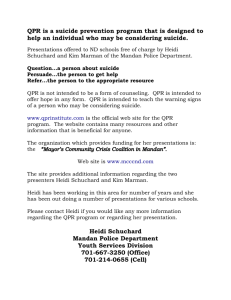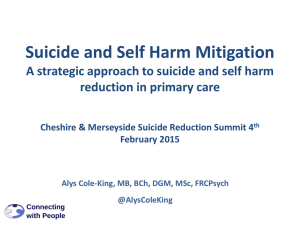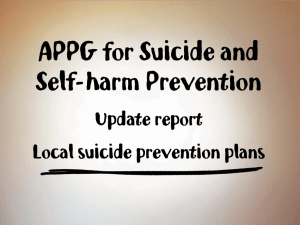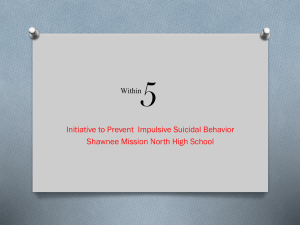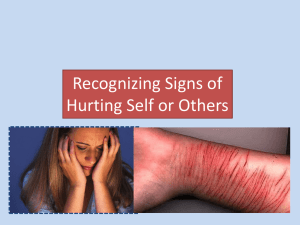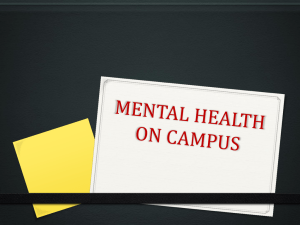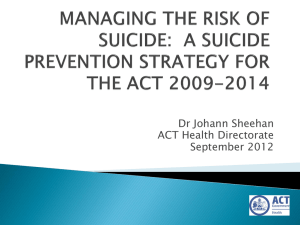Selling an Idea or a Product
advertisement
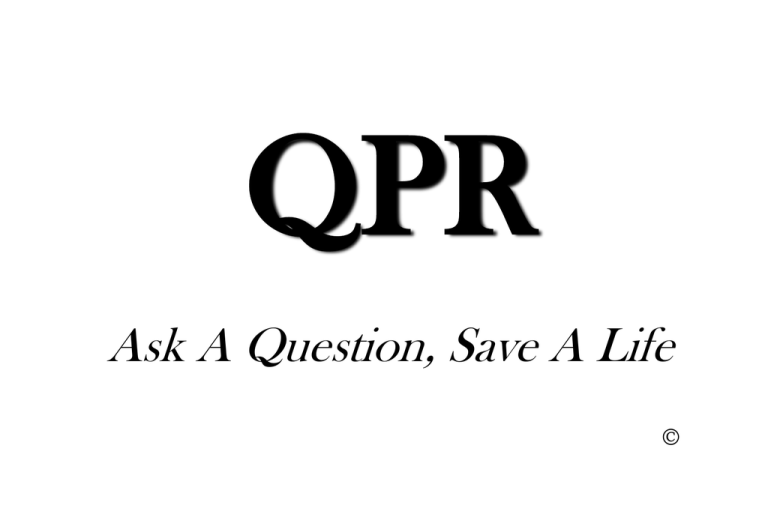
QPR Ask A Question, Save A Life © QPR Question, Persuade, Refer © QPR • QPR is not intended to be a form of counseling or treatment. • QPR is intended to offer hope through positive action. © QPR Suicide Myths and Facts • Myth • Fact • Myth • Fact • Myth • Fact No one can stop a suicide, it is inevitable. If people in a crisis get the help they need, they will probably never be suicidal again. Confronting a person about suicide will only make them angry and increase the risk of suicide. Asking someone directly about suicidal intent lowers anxiety, opens up communication and lowers the risk of an impulsive act. Only experts can prevent suicide. Suicide prevention is everybody’s business, and anyone can help prevent the tragedy of suicide © QPR Myths And Facts About Suicide • Myth • Fact • Myth • Fact • Myth • Fact Suicidal people keep their plans to themselves. Most suicidal people communicate their intent sometime during the week preceding their attempt. Those who talk about suicide don’t do it. People who talk about suicide may try, or even complete, an act of self-destruction. Once a person decides to complete suicide, there is nothing anyone can do to stop them. Suicide is the most preventable kind of death, and almost any positive action may save a life. How can I help? Ask the Question... © QPR Suicide Clues And Warning Signs The more clues and signs observed, the greater the risk. Take all signs seriously. © QPR Direct Verbal Clues: • • • • • “I’ve decided to kill myself.” “I wish I were dead.” “I’m going to commit suicide.” “I’m going to end it all.” “If (such and such) doesn’t happen, I’ll kill myself.” © QPR Indirect Verbal Clues: • “I’m tired of life, I just can’t go on.” • “My family would be better off without me.” • “Who cares if I’m dead anyway.” • “I just want out.” • “I won’t be around much longer.” • “Pretty soon you won’t have to worry about me.” © QPR Behavioral Clues: • • • • • • • • Any previous suicide attempt Acquiring a gun or stockpiling pills Co-occurring depression, moodiness, hopelessness Putting personal affairs in order Giving away prized possessions Sudden interest or disinterest in religion Drug or alcohol abuse, or relapse after a period of recovery Unexplained anger, aggression and irritability © QPR Situational Clues: • • • • • • • • • Being fired or being expelled from school A recent unwanted move Loss of any major relationship Death of a spouse, child, or best friend, especially if by suicide Diagnosis of a serious or terminal illness Sudden unexpected loss of freedom/fear of punishment Anticipated loss of financial security Loss of a cherished therapist, counselor or teacher Fear of becoming a burden to others © QPR Tips for Asking the Suicide Question • • • • • • If in doubt, don’t wait, ask the question If the person is reluctant, be persistent Talk to the person alone in a private setting Allow the person to talk freely Give yourself plenty of time Have your resources handy; QPR Card, phone numbers, counselor’s name and any other information that might help Remember: How you ask the question is less important than that you ask it © Q QUESTION Less Direct Approach: • “Have you been unhappy lately? Have you been very unhappy lately? Have you been so very unhappy lately that you’ve been thinking about ending your life?” • “Do you ever wish you could go to sleep and never wake up?” © Q QUESTION Direct Approach: • “You know, when people are as upset as you seem to be, they sometimes wish they were dead. I’m wondering if you’re feeling that way, too?” • “You look pretty miserable, I wonder if you’re thinking about suicide?” • “Are you thinking about killing yourself?” NOTE: If you cannot ask the question, find someone who can. © How Not to Ask the Question “You’re not suicidal, are you?” “You wouldn’t do anything stupid would you?” © P PERSUADE HOW TO PERSUADE SOMEONE TO STAY ALIVE • Listen to the problem and give them your full attention • Remember, suicide is not the problem, only the solution to a perceived insoluble problem • Do not rush to judgment • Offer hope in any form © P PERSUADE Then Ask: • Will you go with me to get help?” • “Will you let me help you get help?” • “Will you promise me not to kill yourself until we’ve found some help?” YOUR WILLINGNESS TO LISTEN AND TO HELP CAN REKINDLE HOPE, AND MAKE ALL THE DIFFERENCE. © R REFER • Suicidal people often believe they cannot be helped, so you may have to do more. • The best referral involves taking the person directly to someone who can help. • The next best referral is getting a commitment from them to accept help, then making the arrangements to get that help. • The third best referral is to give referral information and try to get a good faith commitment not to complete or attempt suicide. Any willingness to accept help at some time, even if in the future, is a good outcome. © REMEMBER Since almost all efforts to persuade someone to live instead of attempt suicide will be met with agreement and relief, don’t hesitate to get involved or take the lead. © For Effective QPR • Say: “I want you to live,” or “I’m on your side...we’ll get through this.” • Get Others Involved. Ask the person who else might help. Family? Friends? Brothers? Sisters? Pastors? Priest? Rabbi? Bishop? Physician? © For Effective QPR • Join a Team. Offer to work with clergy, therapists, psychiatrists or whomever is going to provide the counseling or treatment. • Follow up with a visit, a phone call or a card, and in whatever way feels comfortable to you, let the person know you care about what happens to them. Caring may save a life. © REMEMBER WHEN YOU APPLY QPR, YOU PLANT THE SEEDS OF HOPE. HOPE HELPS PREVENT SUICIDE. © Reducing a Suicidal Person’s Access to Firearms – Bonus Module Recommendations for Gatekeepers on Reducing Gun Violence The QPR Institute wishes to thank Elaine Frank and Cathy Barber of Dartmouth and Harvard Universities for their contributions to this QPR gatekeeper training program! What you are about learn is an approved derivative program from Counseling Access to Lethal Means (CALM) - an AFSP/SPRC Registered Best Practice training program. Sri Lanka & Pesticides • Pesticides are the leading suicide method in Sri Lanka. • Restrictions were placed on sales of the most highly human-toxic pesticides in the mid to late 1990s. • Suicide rates dropped 50% from 1996 to 2005. • Nonfatal poisonings and suicide by other methods did not drop. Gunnell 2007. Int’l J of Epidemiology. United Kingdom & Domestic Gas • Before 1960, domestic gas was the leading method of suicide in the United Kingdom. • By 1970, almost all domestic gas in the UK was non-toxic. • Suicide rates dropped by nearly a third. • The drop was driven by a drop in gas suicides; non-gas suicides increased slightly. Source: Kreitman 1976, Brit J Prev Soc Med. Why Does Reducing Access to Firearms Work to Prevent Suicide? Why Means Matter • Suicidal crises are often relatively brief. • Suicide attempts are often undertaken quickly with little planning. • Some suicide methods are far more deadly than others (“case fatality” ranges from 1% for some methods to 85-90% for the most deadly). • 90% of those who survive even nearly-lethal attempts do not go on to later die by suicide. See: www.meansmatter.org for studies examining each of these concepts. Focus on Firearms • Firearms are the leading suicide method in the U.S. • Gun owners and their families are at about 3 times higher risk of suicide than non-gun owners. • This isn’t because they’re more suicidal. Gun owners are NO more likely to be mentally ill, to think about suicide, or to attempt suicide. • Rather, they’re simply more likely to die in a suicide attempt. Sources: - Miller M, Injury Prevention 2009 Findings also in ICARIS-2 survey - Betz M, Suicide Life Threat Behavior, 2011. Miller M, Injury Prevention, 2009. Ilgen M, Psychiatr Serv, 2008. Sorenson & Vittes, Eval Rev, 2008. Reducing a Suicidal Person’s Access • A simple step to increase a suicidal person’s safety is to reduce access to firearms at home. • Many counselors and providers and family members of at-risk people don’t think to do this. • This temporary safety intervention is not anti-gun. Making a Difference • Family and friends can protect a suicidal person by temporarily storing all firearms away from home. – Have a trusted person outside the home hold onto them until the situation improves. – Some storage facilities, police departments, gun clubs, and gun shops will store guns. • If off-site storage isn’t an option: – Lock the guns at home with new locks or combinations. – Keep ammunition out of the home or locked separately. – Or, remove a key component of the guns, e.g., the bolt. To keep him safe… … when, as a young man, Abraham Lincoln was depressed and suicidal, a friend said of him, “Lincoln told me that he felt like committing suicide often.” Seeing suicide warning signs, Lincoln’s neighbors mobilized to keep him safe, watching over him, and removing his knives and pistol. They pulled together the same kind of safety net QPR gatekeepers can build today – and which included making sure our President did not have access to the means of suicide. It was said that when he again became depressed later in life he “dared not carry even a pocket knife… “ Source: Lincoln’s Melancholy, A.W. Shenk, Houghton, Mifflin, Co. 2005 For more information Means Matter website: www.meansmatter.org Take CALM-Online—free, online course on Counseling on Access to Lethal Means http://training.sprc.org/ Request technical assistance from Means Matter cbarber@hsph.harvard.edu Request an in-person CALM training elaine.m.frank@dartmouth.edu Last slide • • • • • Name Contact information Customized referral Crisis lines Your election…

